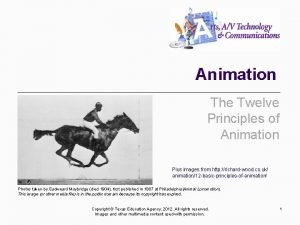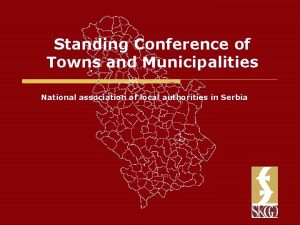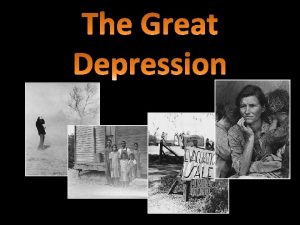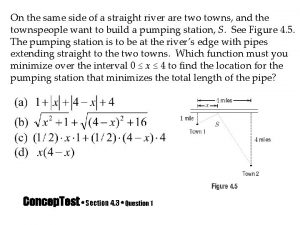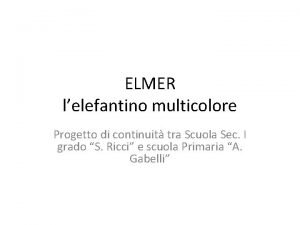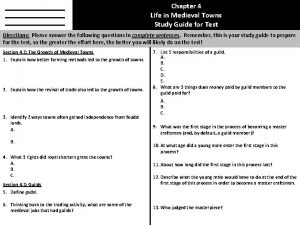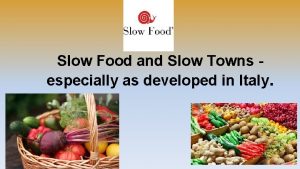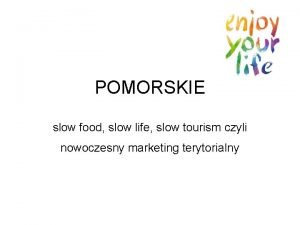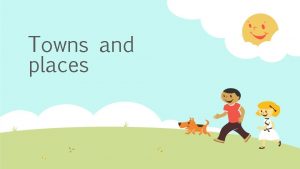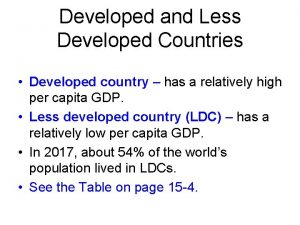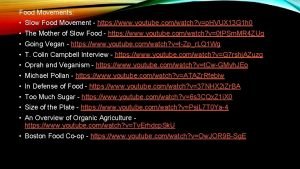Slow Food and Slow Towns especially as developed












- Slides: 12

Slow Food and Slow Towns - especially as developed in Italy By Michelle Adams S 00077675 Mark Abad S 00020680

Overview of Slow Movement. Slow food and slow town is a growing cultural shift towards slowing down. It is a movement to address the issue of ‘time poverty’ through making connections. The slow movement promotes connectedness. People are searching to connect with: The fast-paced life in today’s society has weakened these connections. Technological advances have meant that the work society does is different to the work they have done in the past and it is less connected to living and life than it has been in the past. People in society are engaged in constant fast-forward motion whereby they are often overscheduled, stressed and rushing towards the next task. This rushing around is not only restricted to the work environment. Society often rush their food, family time and recreation activities. This has led to a disconnect in their lives. The Slow movement aims to resolve this disconnection.

The symbol of the snail was chosen because it moves slowly and calmly eats its way through life. Origins and Aims of Slow Food and Towns d the emo nea ope nstra r th ning tion e. P iaz of a M again za di S c. Don st was headed pag ald na 's by Carlo Petrini orig i Itali nated fr an t own om sma ll calle d Br a in Ro me . The Slow Food movement is a contrast to the fast food values. Slow Food is a reference to living an unhurried life, beginning at the table. “Cittaslow” is an Italian idea developed from the Slow Food movement. Cittaslow towns take the time to identify what is important and special about that town and its surrounding area and put in place strategies to preserve their unique qualities, making life better for everyone. Slow cities are characterised by a way of life that supports people to live slow. Traditions and traditional ways of doing things are valued. These cities stand up against the fast-lane, homogenised world so often seen in other cities throughout the world. Slow cities have less traffic, less noise, fewer crowds.

Key Principles of the Slow Movement Implement an environmental policy which nurtures the distinctive features of that town or city and its surrounding area, and focuses on recycling & recovery Put in place infrastructure with a focus on environmentally-friendly use of land Preserve the history of a region, the important buildings and historical locations and making sure they are identified, protected and maintained Encourage the use of technology that will improve the quality of air and life in the city Support the production and consumption of organic foodstuffs Protect and promote products which have their roots in tradition and reflect a local way of doing things Encourage learning about food and where it comes from Encourage a spirit of genuine hospitality towards guests of the town or city

The Slow Movement intends to provide individuals with the tools to prevent their existence to be merely a succession of chained scenarios void of emotions. It aims to preserve the pleasures of good living, good food, family, and friends.

Connection to Food. Think About? ? ? Food is part of our cultural identity and cultural One of the most basic area of connection for the slow movement is in the area of food – all aspects of the food system. This means we need to connect to: ● Traditional seeds; ● Food production; ● Food sourcing; ● Food buying; ● Food preparation; ● Traditional recipes and ingredients; ● Food consumption; and ● Waste food disposal. heritage. The slow movement aims to preserve this identity, and to keep the connection between the food we eat and the land it comes from. Does it matter where our food comes from? Do we, our communities, and the planet do better if preserving our culturalwe heritage the slow movement we choose food grown by Inlocal sources trust? and the slow food movement in particular also preserves our physical environment by supporting and promoting sustainable systems of agriculture such as organic and biodynamic, and the use of traditional seeds and agricultural practices.

Connection to Place. One of the tenets of the Slow Movement is to preserve cultural heritage. This is especially clear in the slow food movement where one of the emphasises is on traditional ways of preparation, serving and consumption of traditional foods, using traditional recipes. The emphasis on cultural heritage is no less important in other areas of the slow movement where we make a deep connection to place, people, and culture. Cultural heritage refers not only to the physical qualities and attributes (both natural and human-made) of places but also to their historic, or social value for past, present or future generations. When we focus on developing or maintaining a connection to place our emphasis is on bioregionalism and supporting local economies, and through that, supporting local communities to engage in traditional activities. When we live, work, eat, source our food, and pursue recreation within our bioregion, we are building a connection to place and to the cultural heritage of the bioregion.

Connection to People The slow movement is about slowing down and having richer relationships with people. Not just our partner, but our entire family, our friends, our workmates, our neighbours, and anybody else we meet. Think About? ? ? A rich relationship is one where there is a deep connection based on loving-kindness. How many of us don’t know the names of our neighbours? Rich relationships make rich lives Do we focus on ourselves, or do we focus on the people around us? When we connect to people in our community or neighbourhood we also connect to place and to the slow movement. In the fast-lane lives people don’t have time to slow down and talk and listen to others.

Connection to Life Think About? ? ? To connect to life is to connect to every aspect of our lives. Most important of all is to connect to ourselves, and to our own movement within life. That is, to connect to our body and our mind, to connect to spirituality, to our stage in life, to connect to the natural rhythms that guide us, and to connect to death and dying – a natural part of life. The most difficult part of connecting to life is to slow our mind enough to even see what we need to do. What does connecting to life mean? What can I do to feel more Some peopleconnected? choose not to move where they live in order to join the slow movement, but to stay and dramatically slow down and change their lives in order to connect to life. Jeremiah 2: 25 - “Slow down. Take a deep breath. What's the hurry? Why wear yourself out? Just what are you after anyway? ”

Moving Forward Slowly Restoring balance in our lives - slowing down and reconnecting with what is important The success and support of the Italian Slow Food Movement has inspired people all over the world to take control of their lives. A life where tradition and traditional ways of doing things are valued. The slow movement philosophy is now applied to different essential areas of people’s lives: Slow travel- connecting to culture & moving away from hectic holiday tours Slow education- emphasising on pursuit of knowledge & joys of learning Slow books- rediscovering the love of reading good books Slow work- working flexible hours and less rigid schedules

Catholic Social Teaching The Principle of Subsidiarity • The slow movement allows practice of love of neighbour which is then extended to the whole global community • The slow movement enables participation of and among those who make up the community • The slow movements fosters life within a group/community, without undue social control and unwarranted interference The Right of Association • The slow movement allows people to grow together and achieve fulfilment by association with others • The slow movement enables people to be true to themselves by relating to others The Principle of Participation • The slow movement gives people the opportunity in shaping a more just and human society, seeking together a common good and well-being of all • The slow movement allows people to take a more active role in the development of the socioeconomic and cultural life of their world.

Want to know more? You can access these sites: • www. slowmovement. com • www. cittaslow. org. au • www. slowfood. com • www. citta-slow. com You can view these clips: • https: //www. youtube. com/watch? v=p. POe_if_Qcw • http: //www. ted. com/talks/jamie_ol iver • https: //www. youtube. com/watch? v=ac. VJp 9_v. ODo By Mark and Michelle
 Slow in slow out animation
Slow in slow out animation Arizona league of cities and towns
Arizona league of cities and towns Standing conference of towns and municipalities
Standing conference of towns and municipalities X ray mastoid towne's view cholesteatoma
X ray mastoid towne's view cholesteatoma Fire island map towns
Fire island map towns Disadvantages of shanty towns
Disadvantages of shanty towns Hoover towns
Hoover towns Towns near dedham ma
Towns near dedham ma On the same side of a straight river are two towns
On the same side of a straight river are two towns Rural development loan massachusetts
Rural development loan massachusetts Progetto elmer scuola primaria
Progetto elmer scuola primaria Life in medieval towns answer key
Life in medieval towns answer key Iron tools and agriculture
Iron tools and agriculture
